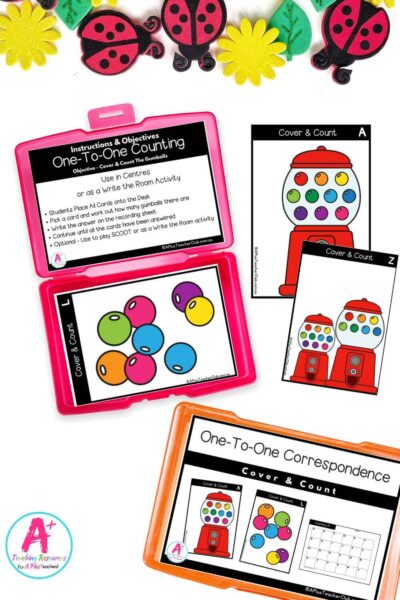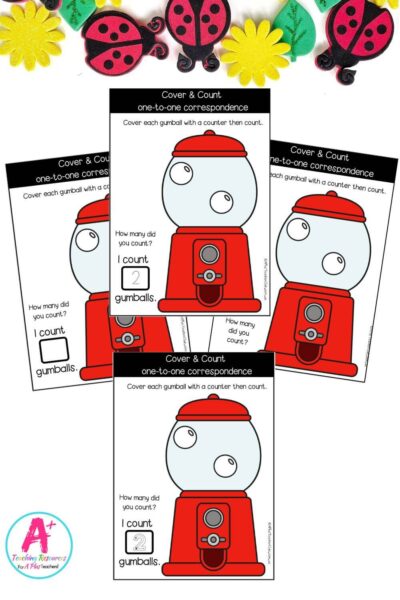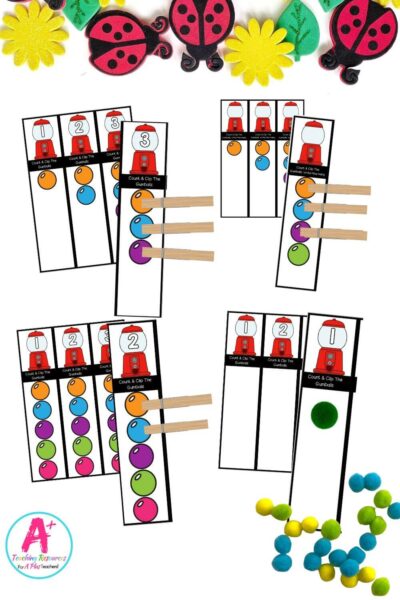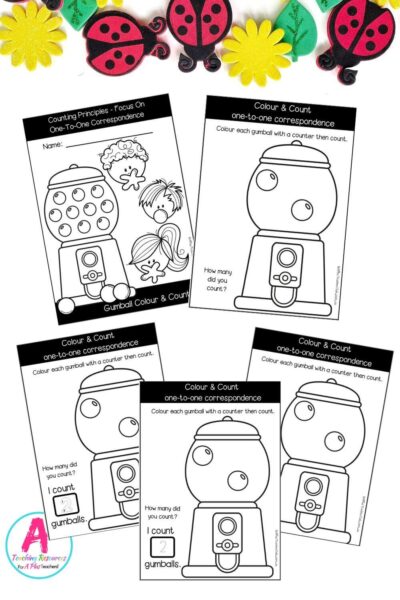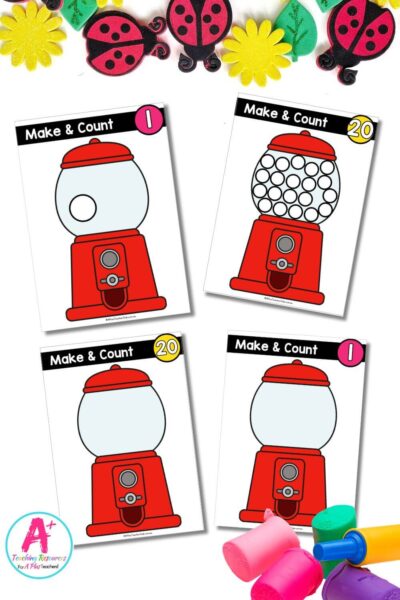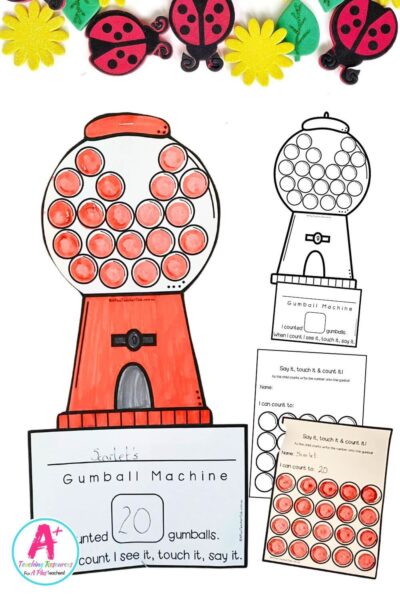One-to-One Correspondence Activities
Number Sense
One of the first steps in developing strong number sense is mastering one-to-one correspondence and cardinality. These essential early math skills help children understand that numbers represent real quantities and set the stage for future mathematical understanding.
In this post, we’ll explore what these concepts mean, why they matter, and a collection of engaging one-to-one correspondence activities to use in your classroom—along with some fantastic picture books to reinforce these concepts.
What is One-to-One Correspondence?
One-to-one correspondence is the ability to match one object to one number word while counting. For example, if a child is counting blocks, they should touch or move each block as they say the number aloud. This skill prevents children from skipping numbers or counting the same object multiple times.
Picture Books That Reinforce One-to-One Correspondence:
- “Ten Black Dots” by Donald Crews – A simple and engaging book that encourages children to count objects on each page.
- “Mouse Count” by Ellen Stoll Walsh – A fun story about a snake collecting mice, helping children count each one correctly.
- “Feast for 10” by Cathryn Falwell – A great book for reinforcing counting and real-life applications of one-to-one correspondence.
What is Cardinality?
Cardinality is the understanding that the last number counted represents the total quantity of objects. For example, if a child counts five bears, they should recognize that the group contains five—not just a sequence of numbers.
Picture Books That Reinforce Cardinality:
- “Anno’s Counting Book” by Mitsumasa Anno – This wordless book visually represents numbers, showing how the last number counted tells how many in total.
- “How Many?” by Christopher Danielson – Encourages students to think beyond just counting and focus on understanding total amounts.
The 5 Counting Principles
To support the development of these concepts, we can use the 5 Counting Principles that guide young learners in understanding how to count correctly:
- The Stable Order Principle: The order of counting words (one, two, three, etc.) must always remain the same.
- The One-to-One Principle: Each object being counted must receive exactly one number name.
- The Cardinality Principle: The last number counted represents the total number of objects in the set.
- The Abstraction Principle: Objects can be counted no matter what they are (they do not have to be identical).
- The Order Irrelevance Principle: It doesn’t matter in what order you count the objects—whether you start from the left, right, or middle, the total will remain the same.
By introducing these principles, you can help students develop a deeper understanding of counting and numbers. Now, let’s explore some one-to-one correspondence activities and supporting resources, including picture books that can make these concepts engaging and accessible for all learners.
How To Teach One-To-One Correspondence
One-to-one correspondence is more than just counting—it involves a combination of skills that children must use simultaneously to develop a strong number sense. Teaching this concept effectively means helping students grasp the following key ideas:
- Knowing the counting sequence – Before children can count objects accurately, they need to understand the stable order of numbers and be able to recite them correctly.
- Assigning one number to one object – Each object in a set must be counted only once, reinforcing the idea that each number represents a specific quantity.
- Understanding that each number is one more than the last – As children count, they should recognize that each number in the sequence represents an increase of exactly one more than the previous number.
- Identifying the last number as the total quantity – The final number said when counting represents the total number of objects in the set, demonstrating an understanding of cardinality.
Mastering these steps is essential for developing strong number sense and laying the foundation for future math skills. When children understand how numbers correspond to objects, they gain confidence in counting, recognizing patterns, and making connections between quantities and numerical symbols.
Teaching one-to-one correspondence in a structured and engaging way ensures that students build a solid mathematical foundation that will support them as they progress to more complex concepts. You must remember that students need to know how to rote count first! If they cannot rote count, then they are simply not ready to learn one-to-one correspondence skills yet.
Teaching One-to-One Correspondence Through Picture Books
Using engaging picture books is a powerful way to reinforce one-to-one correspondence, helping young learners develop essential counting skills in a meaningful and enjoyable way. The books below not only support one-to-one correspondence but also introduce key math concepts that build a strong foundation for early numeracy.
Picture Books & How They Teach One-to-One Correspondence
- Ten Black Dots – Donald Crews
- Concept: Counting, number recognition, and grouping objects.
- Use: Children can count the black dots on each page and explore different ways to arrange and use them in creative ways.
- Mouse Count – Ellen Stoll Walsh
- Concept: Counting forward and backward, number conservation.
- Use: Children count mice as they are placed in and taken out of a jar, reinforcing the idea that numbers represent quantities.
- Anno’s Counting Book – Mitsumasa Anno
- Concept: Counting in context, number sequencing.
- Use: Each page gradually introduces more objects, helping children see the relationship between numbers and real-world quantities.
- Feast for 10 – Cathryn Falwell
- Concept: Counting objects in daily life, number order.
- Use: Children count food items as a family prepares a meal, making counting relatable to everyday experiences.
- Five Little Ducks – Raffi
- Concept: Counting down, subtraction, number sequencing.
- Use: As each duck disappears and returns, children practice tracking changing quantities and recognizing how numbers decrease.
- How Many? – Christopher Danielson
- Concept: Subitizing, recognizing quantities in different arrangements.
- Use: This book encourages children to think about numbers visually and explore different ways to count the same group of objects.
- Ten is a Crab – Emily Bannister
- Concept: Counting to ten, number composition.
- Use: The book presents groups of ten in nature, encouraging children to count and see how numbers can be grouped in different ways.
Using These Books in One-to-One Correspondence Activities
- Have children touch and count each object in the book as they say the numbers aloud.
- Use manipulatives (e.g., counters, buttons) to recreate scenes from the book to reinforce one-to-one correspondence.
- Encourage story-based counting games, such as placing objects in a jar (like in Mouse Count) or removing items as a story progresses (like in Five Little Ducks).
By integrating these books into math lessons, young learners gain hands-on, engaging practice with counting principles, helping them build a strong foundation for future mathematical understanding.
How to Support Students Who Struggle with Counting
If a child struggles with one-to-one correspondence or cardinality, try these strategies:
- Model counting aloud while touching each object: Slow down the counting process by clearly articulating each number as you point to or touch each item. This helps students understand the concept of one-to-one correspondence.
- Use a counting pointer: A visual tool like a counting pointer can help students track their counting process, making it easier for them to follow along and stay engaged.
- Pair students with a counting buddy: Provide peer support by having students work with a counting buddy. This encourages collaboration and gives struggling learners the chance to learn from their peers.
- Incorporate songs and rhythms: Counting songs or rhythmic activities can make counting more engaging and memorable for young learners. The structure of these activities reinforces the counting sequence in a fun and interactive way.
- Use concrete manipulatives: Materials like counters, buttons, or small toys give students a hands-on experience with counting. These tactile tools help children connect numbers with real-world quantities, supporting their understanding of the concept.
- Provide visual aids: Use number lines, charts, or picture books to visually represent counting and cardinality. Visual aids help struggling students connect abstract mathematical concepts to tangible examples they can understand.
- Allow extra time for practice: Give children the opportunity to practice counting at their own pace. Repetition and time for reflection will help solidify their understanding of the relationship between numbers and quantities.
- Work in small groups: Small-group instruction allows you to offer targeted support and personalised activities for struggling learners. This focused attention can help address individual needs and build confidence in counting skills.
Final Thoughts
Teaching counting through one-to-one correspondence activities not only helps young learners build confidence and accuracy but also fosters a deeper understanding of numbers. By engaging students with hands-on activities and complementing them with picture books, we create a meaningful learning experience that reinforces key concepts in a fun and engaging way. These activities support the 5 Counting Principles—Stable Order, One-to-One, Cardinality, Abstraction, and Order Irrelevance—providing a solid foundation for future mathematical learning.
Below is a collection of one-to-one correspondence activities. Click to start downloading and enhance your students’ counting skills!
Resources listed in this collection
Click to jump to...-
One-To-One Correspondence – Task Cards 1-20 – Gumballs
-
One-To-One Correspondence - Cover & Count 1-20 - Gumballs
-
One-To-One Correspondence – Count & Clip – Gumballs
-
One-To-One Correspondence - Student Booklet 1-20 - Gumballs
-
One-To-One Correspondence – Playdough Mats – Gumballs
-
One-To-One Correspondence – Assessment / Craft – Gumballs
One-to-one Correspondence - Gumball Math Centres
More Counting Principles Activities
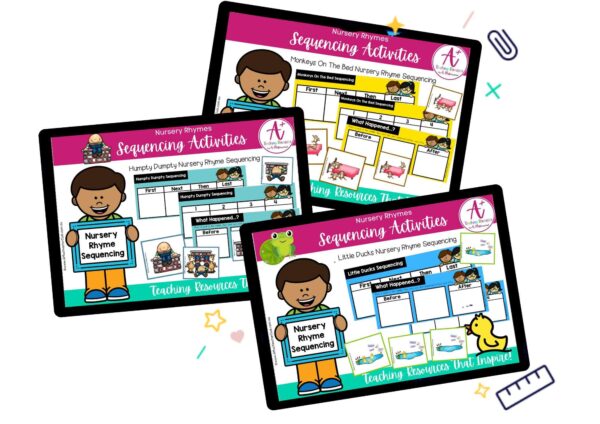
Classroom Themes - Nursery Rhymes Sequencing
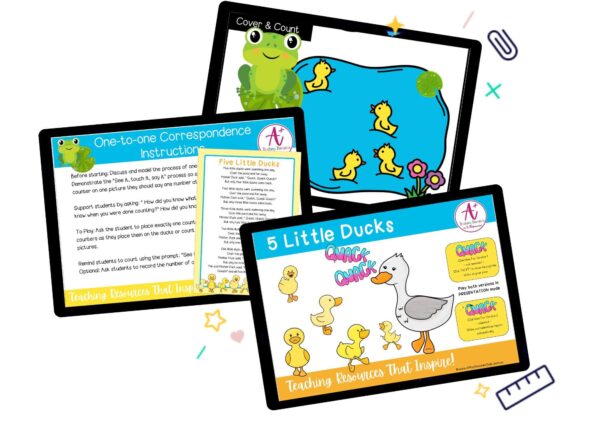
Classroom Theme Resources - Nursery Rhymes
Can't find what you're looking for?
Send us a request! Use this form to request a resource. Please give details of the learning area, topic, year level, curriculum links. We’ll be happy to take a look to see if we can fit it in. Unfortunately a request does not guarantee we will be able to make it!
"*" indicates required fields

